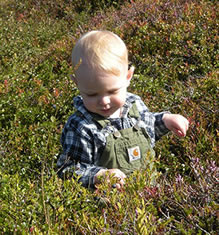 |
Author's grandson; his first berry picking; Author photo |
| |
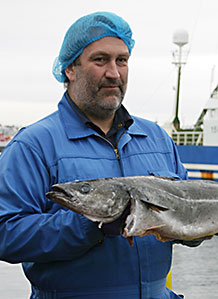 |
Fruit de mer;
Photo by Vicki Hoefling Andersen |
| |
 |
Greenery in town;
photo by Vicki Hoefling Andersen |
|
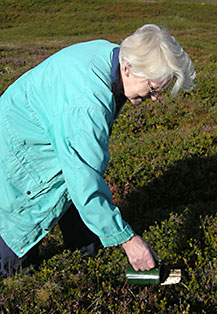 |
Homemade berry scoop; Author photo |
|
You enter a rocky valley and notice the scrub. Crouch down and berries come clear: pink, green, glaucous blue. You whip off your gloves and dig in your backpack for a container, suspending thought of the trail ahead. We are born to hunt for globular things, from speckled eggs to burls and even misty gobs of beach glass.
Pulling berries from a bush is a form of wealth-getting. “We will take our berries home and can them,” says the mother in McCloskey’s Blueberries for Sal. Today we think of wealth as the result of clever dealings with man-made systems, but until recently everyone knew that economies grow from habitat. Prosperity hinges on territory. Hence trade. Hence war. We wear diamonds or amber to flaunt our wealth of habitat: we flash the appearance of sparkling water and glowing fruit.
For a long time my habitat was near Reykjavik, Iceland, at 64° N. There, edible wealth grows mainly offshore, silver and scaly: fruits de mer. On shore, no fruit bigger than a pearl grows unassisted.
For fruit you need soil, and for soil you need organic matter, itself the fruit of eons. The town where I lived, Hafnarfjörður, rests on 7,000-year-old lava, a riot of basalt twists and pinnacles. Gray racomitrium moss lies over it like frost; grass and flowers grow in rifts. East of town the rock is younger and utterly bare; near Eyjafjallajökull, it has yet to cool. Newborn rock is barren as the moon. Though rich in water, Iceland is Europe’s largest desert.
Life likes to appear. Lichen blooms on basalt in rusty splotches. Where erosion mingles clay and lichen crumbs, low plants like campion and thyme crop up. Mosses thrive in crannies and nourish each other until they can support flowers big enough for a bee to land on. Slowly heath comes into being, a sweet-smelling carpet of plants so tough, you can scour pots with them.
A classic Icelandic children’s book frankly explains, “We live in a cold place, where only grasses can grow. We can’t digest grass, so we eat animals that can, such as sheep and cows.”
But Iceland does have native trees, low and gnarled as they may be. Scrub willows huddle by mountain streams. The local birch, or ‘perfume bark’ in Icelandic, smells like sweet spice and has a fierce will to live. After the recent eruption at Eyjafjallajökull, a ranger surveying the gray devastation stood amazed as a tinkling sound, like ice cubes in glasses, began all around him: the birch buds were breaking through glassy coats of ash to leaf out.
Unaware of the fragility of volcanic soil, Norse settlers cleared the native trees and let their stock range free, nibbling saplings. Now the wind skirls up loose soil. In Collapse, Jared Diamond calls Iceland’s environment one of the most degraded in the world. Elsewhere one flees the city in search of green; in Iceland, the greenery is mostly in town.
Transplanted from New England, I sometimes woke from dreams of hardwood trees. I pined for canopies of chittering life. In the hills of Reykjanes you are lucky to see a raven. The only mammal native to Iceland is the Arctic fox.
But not all aesthetic joy stems from fertility. The slant of northern light makes whole days pink and gold. The sun smolders on snowy peaks as jagged as fish spines. Auroras and nacreous clouds ache with a high-lonesome beauty. Coming back from a trip home I once closed my eyes against the sight of Keflavik’s barren plain, only to reopen them at a gasp of pleasure from my fellow passengers: the plane was taxiing through a lake of violet fire, a field of lupine.
In April, between sleet squalls, I walked the cobble shore and eyed the tasty-looking vermillion nodes that grow on kelp roots. In May I nibbled scurvy grass. Then suddenly it was June, when night is vanquished, gentians riot, spirits soar; the radio declares, “Sun holiday, sun holiday, this factory is closed due to good weather.” By late August, the endless light has conspired with stonecrop, bartsia, sedums, ling, bearberry, and other sisters of the moor to produce vaccinium myrtillus, bilberry, or “chief berry” in Icelandic—blueberries to any tongue.
My mother-in-law had a homemade berry scoop, an old tin can with tines soldered on, painted a durable lead-green. For years she and her husband picked each fall, in a certain Happy Valley facing due north on the Arctic.
Four generations of our family once met up there. We spanned eighty years to eighteen months, false teeth to milk teeth. The oldest struggled down on her knees and the baby sat chest-deep and picked and ate with no instruction. The haze of next winter lay far out to sea. We brought our treasure home, picked over and stored it, and then hurried, sunburnt, to the hospital where my father-in-law lay stunned from a stroke.
We told him we’d been berrying, and where. His eyes grew canny and interested. “Gobs of berries,” we told him. “We picked all day.”
“Good,” he said.
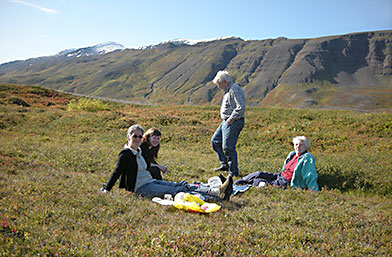
Sarah Brownsberger is a writer and Icelandic-English translator. She can be reached at: [email protected]
|
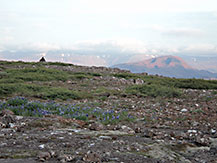 |
Purple lupines on Helgafell at midnight; Author photo |
| |
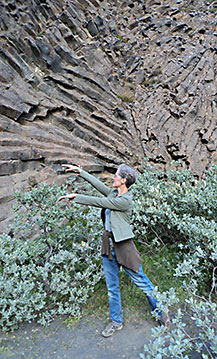 |
The author dances with basalt |
| |
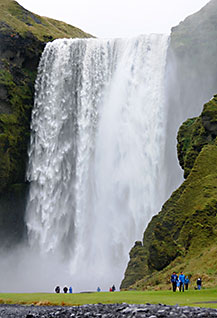 Rich in water; Skogafoss;
photo by Vicki Hoefling Andersen
Rich in water; Skogafoss;
photo by Vicki Hoefling Andersen |
|